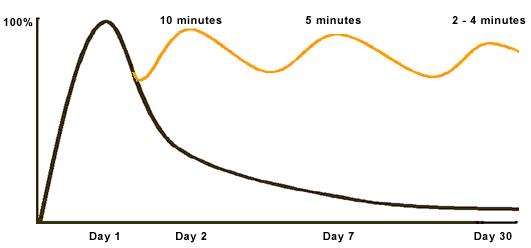Jeff Gothelf 's presentation about "Culture of Innovation"
https://www.youtube.com/watch?v=Qc-cazqaUY8
I believe innovation do come from the people and the team and the culture that facilitate it.
In the current uncertain, fast changing world, organizations all over the world crave for innovation however, it cannot be achieved by slogan, bureaucracy or me-too strategies. It involves changing people's mindset, believe and company culture.
Tangible well-defined product production => continuous, never-ending, on-going development and improvement cycle.
The Questions
What is this continues means for business, How it change our ongoing conversation with customers?
What we take advantage of the new information? Qualitatively or quantitatively
How we maximize the creativity, the learning and productivity of our team
Questions about team creation
1) Anatomy of the team
Anti-patterns (not to do)
- silos, service provider, no view of "whole", no collaboration
>> small team, co-location, dedicated, self-sufficient(coding, QA, design etc...)
2) How do we task the team?
Anti-pattens (not to do)
- road map(fixed scope, fixed time, etc.) should list of questions not list of features
3) How should the team work?
Culture of innovation => culture of experimentation, encourage learning/try new things
- Small team 6 - 8, self-organized team
- Mix talents who assign work depend on individual capability not fixed role
- No roadmap -> no fixed deadline -> no fixed features
- Roadmap or plan are defined by a set of question to be answer
- Not rewards by features implemented but learning objectives
- No fixed yearly budget, but quarter learning goals to be presented to company and asked for endorsement.
SBC - Single Board Computers - Raspberry Pi, BeagleBone, ...
After I visited Embedded World 2015, we found a growing number of industry people using Raspberry Pi for project prototypes or even in actual projects. Then I started to study the trend of using open hardware/open source SBC - Single Board Computer.
I bought 2 Raspberry 2 Pi Model B (HK$275 each) from RS. There is others online seller Element14(they are more for company than individual). I preordered on PS, it said 1 months and eventually, I got them in just 2 weeks. Now they are in stock, HK$310.
I was really surprised by the price and performance....HKD$275 for 900MHz Cortex A7, Qual-core, GPU, Open GL, OpenVG, 1GB RAM, 1080p30 H.264 video....
Giving the price/performance advantage, it did show up as popular SBC.
From post on linux.com, https://www.linux.com/news/embedded-mobile/mobile-linux/773852-top-10-open-source-linux-and-android-sbcs.
Top 10
1. Raspberry Pi Model B -- 1,136 (243, 148, 111)
2. BeagleBone Black -- 814 (154, 138, 76)
3. Odroid-U3 -- 194 (38, 31, 18)
4. CubieTruck -- 193 (36, 28, 29)
5. Banana Pi -- 186 (18, 41, 50)
6. Parallella -- 164 (32, 16, 36)
7. Cubieboard2 -- 158 (21, 27, 41)
8. A10-OLinuXino-Lime -- 138 (30, 20, 8)
9. Galileo -- 135 (11, 30, 42)
10. Udoo Quad -- 128 (19, 24, 23)
2. BeagleBone Black -- 814 (154, 138, 76)
3. Odroid-U3 -- 194 (38, 31, 18)
4. CubieTruck -- 193 (36, 28, 29)
5. Banana Pi -- 186 (18, 41, 50)
6. Parallella -- 164 (32, 16, 36)
7. Cubieboard2 -- 158 (21, 27, 41)
8. A10-OLinuXino-Lime -- 138 (30, 20, 8)
9. Galileo -- 135 (11, 30, 42)
10. Udoo Quad -- 128 (19, 24, 23)
Only top 2, Pi(32.2% 1st choice) and BeagleBone(20.4% 1st choice) have meaning number.
I/my company is considering use Pi for IOT projects. From the survey, the applications are
- Home automation,
- Education,
- Special functions servers,
- Robots/automated vehicles/crafts,
- Arts/entertainment,
- others CE,
- data acquisition/control,
- HMI/Industrial,
- others...
Their listed applications are
{Listed applications include Linux desktops, thin clients, XBMC media players, medical devices, weather stations, amateur and SDR radios, wearables, IoT gizmos, and automotive computers. Two particularly intriguing applications are "fish tank control" and "mining."}
Jack Wong
www.zetakey.com
Subscribe to:
Comments (Atom)
